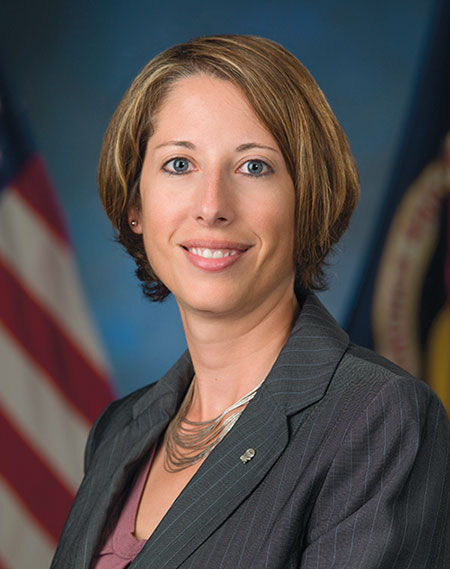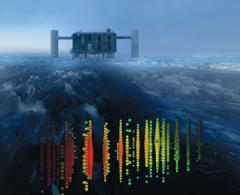
This Article From Issue
November-December 2015
Volume 103, Number 6
Page 377
DOI: 10.1511/2015.117.377
NASA is developing a new system to take humans into space, replacing the Space Shuttle program that ended in 2011. A major component of that system, the Orion spacecraft, had some major tests over the past year (see infographic), and is scheduled for its next test launch in 2018. Aerospace engineer Nujoud Merancy (below), the mission planning and analysis lead for Orion, gave an overview of the spacecraft and its development to managing editor Fenella Saunders.

Image courtesy of NASA.
What will Orion do?
The purpose of Orion is to be the vehicle that safely takes the crew to and from space, and it will have short-duration mission capabilities for humans. We had a test flight in December, and our next one will be in 2018 when we actually will have an almost fully complete vehicle to go out to beyond Earth orbit for a test flight. Then humans are scheduled to be launched in 2023.
What are the pieces of the craft?
There are four essential pieces. The crew module is the capsule-shape design where the crew will actually be inside. It’s a pressure vessel, a heat shield, and a parachute for all the things that the crew needs going to and from space. The service module has the propulsion system, the solar arrays, the radiators for thermal control, and all of the crew consumables—water, oxygen, and nitrogen. The launch abort system is the big tower on the pad, which is useful if an abort is needed soon after launch, and then it jettisons after we get high in the air. The last piece is the spacecraft adapter, which is the ring that attaches Orion to the space launch system, and the protective fairings we jettison upon leaving orbit.
The overall shape of vehicle echoes that from the Apollo missions in the 1960s and 1970s. Has that shape been a design consideration?
The exterior shape of the capsule is very much similar to what Apollo had, because the physics of reentry, heating, and aerodynamics don’t change, regardless of what year it is. But inside, we’re fitting four crew and Apollo only held three. And you can stand up now inside Orion, you have lots of room. It’s about the interior volume of a couple of minivans.
What is your role with Orion?
I’m the mission planning and analysis lead. My role is making sure that the missions we design can be flown by the vehicle. So as we’re going through the design, I’m looking at both the missions that are out there, what we could potentially do with the vehicle, and then the design we’re putting together, to make sure that we’re building a capable vehicle.
How far could Orion go into space?
We will have enough supplies onboard for four crew for up to 21 days. So really we can do anything inside lunar orbit, which includes a distant retrograde orbit, an asteroid mission, or conceivably support for lunar landing type missions. If you wanted to go beyond lunar orbit, like on the way to Mars, then you need a habitat and other vehicles to go with it.
Orion has had a busy year. Can you review the tests and their results?
The most important one in the past year was Exploration Flight Test 1, which was a to-orbit, high-speed entry, which we launched on a Delta IV Heavy rocket (see graphic). On that we had not only our nominal systems and computers and sensors running, but we also had 1,200 additional sensors for measuring the heat on the heat shield, the stress through launch and entry, and the parachute system. We had sensors all over the vehicle to really give us flight test data to correlate our design and our models.
And since then we’ve also had lots of initial testing going on for the next vehicle, which we’re in the process of putting together for testing. The fairing system has been upgraded and there’s been a new test on that already. Right now the Integrated Test Lab, which will be the avionics and software test facility, is really just starting to get built up and recently got their first power and data unit installed.
Parachute testing is also ongoing. Exploration Flight Test 1 actually counted as one big test of the parachute, but then the team also has to test off-nominal conditions. In the last one they did, they tested having a main parachute fail, so it only had two main parachutes on that flight test.
Do these successful results make you feel like this vehicle is really happening?
The thing that gave everyone the most confidence was when we actually had the flight test last year, so we actually got to see it tangibly fly. That makes you feel like, yeah, we’re in this for good.
What are the next tests on the horizon?
The service module for Orion is basically being provided by the European Space Agency, and they’re sending over a test article that actually should arrive next month. Next year that’s going to be put on the test stand that we have up in Ohio, integrated with the two other parts, which can mimic the acoustics and the shaking that the spacecraft experiences when it’s launching.
How are new technologies advancing the testing of Orion?
The Integrated Test Lab needs to be built exactly how the vehicle is being put together, so they have to do these exact cable lengths. Since they don’t have all the avionics delivered yet, they have 3D printed several of the boxes in the exact patterns. That way they can test the cable lengths, so when the box comes in, they know everything’s already ready.
Would you go up into space if you had the chance?
I think I would jump on any chance I got to go to space, so I would love that. I don’t know about a two-year mission to Mars, but a shorter mission for sure.

American Scientist Comments and Discussion
To discuss our articles or comment on them, please share them and tag American Scientist on social media platforms. Here are links to our profiles on Twitter, Facebook, and LinkedIn.
If we re-share your post, we will moderate comments/discussion following our comments policy.